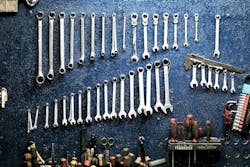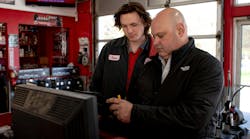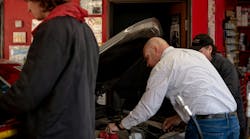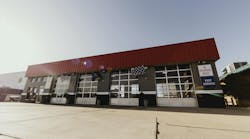In our previous article highlighting the importance of safety in the shop, we discussed the unique oil and lube shop hazard that is the oil change pit. Managing this potential danger is an essential component of keeping service techs safe on the job. However, there are a wide variety of other possible sources of injury that lube shop operators should be on the look out for, many that are shared with other industries and with simple, affordable solutions.
Aside from the basic incentive of keeping workers safe, shop safety has the added bonus of providing the business owner with cheap insurance against expensive and potentially devastating litigation. With OSHA regulations to follow, ambulance-chasing lawyers looking for a payday and even the occasional unscrupulous employee with an eye to cash in, lube shop owners should make sure every possible safety precaution is being taken to protect themselves, their workers and the future of their business.
Personal protective equipment (PPE) should be a key component of any lube shop’s safety strategy. With a few inexpensive and effective additions to employee attire, the likelihood of injury on the job can be substantially reduced.
A Head in the Game
For obvious reasons, protecting workers’ heads should be high on the list of safety priorities. With oil and lube techs spending so much time underneath vehicles and with the fast pace of cars coming and going, there are ample opportunities for bumped skulls and even more serious head injuries. Fortunately, guarding employee noggins is both easy and cost effective. OSHA regulations don’t require hard hats to be worn by oil and lube shop technicians, and these cumbersome headpieces aren’t exactly practical for the oil change environment either. Thankfully, there’s another option — bump caps.
Bump caps come in a variety of shapes, sizes and styles. They range from a simple plastic shell to baseball caps to a number of different designs. Generally speaking they all feature a hard, protective shell, but without the suspension system or bulk of a full-size hard hat. This makes bump caps far less awkward to wear while still offering protection against hard knocks, though, of course, not nearly as much protection as the aforementioned hard hat.
Since they’re lighter in weight and aren’t bound by the stringent regulations and testing standards that hardhats are, bump caps can be made to be significantly more comfortable (and affordable). Many are more like wearing a regular ball cap than a piece of PPE. Comfort and wearability are important things to consider when shopping for bump caps, as all the protection in the world won’t matter if no one wears them.
A good bump cap should have air vents in both the fabric and plastic shell and provide full head coverage. Most are one-size-fits-all, but some also provide various levels of adjustment. To keep the protective headwear looking professional, some bump cap retailers offer customization including the addition of company logos.
Not only can a blow to the head result in a life-altering injury, these wounds tend to be the single most expensive type of workers’ compensation claim, with an average cost of more than $85,000, a $6 bump cap is cheap insurance indeed.
More Than a Sleeve
With employees getting up close and personal with the undersides of automobiles, burns, particularly to the arms and hands, are also a very real danger in oil and lube shops. Hot oil, exhaust headers and manifolds, and other drivetrain components are easy to bump into and can cause nasty burns in the blink of an eye.
Burn sleeves are an easy, and extremely affordable, way to prevent these painful accidents from occurring. These admittedly unattractive pieces of PPE, like bump caps, come in a wide variety of forms. Some burn sleeves are made to be disposable and generally come in large bulk boxes and are made of cotton or some other thick fabric. Others are of higher quality and feature more exotic materials, like Kevlar. Some disposable burn sleeves are even made of Kevlar. The important thing to remember when burn sleeve shopping is the goal is to prevent burns. With this in mind, beware of protective sleeves that look similar, but may not offer the necessary protection from heat.
Glove Treatment
A mechanic’s hands spend more time in harm’s way than perhaps any other part of his or her body. Even a relatively minor injury can be both extremely painful and debilitating. The answer, of course, is a pair of gloves. Mechanics gloves are a dime a dozen. They’re affordable, comfortable and highly effective. They prevent burns, cuts, abrasions and help keep hands cleaner. The only down side to wearing gloves while working on cars is the reduced dexterity can be bothersome at times — a small price to pay for the substantial protection they afford.
Protecting Vision
While eye injuries are generally far more rare than those to the head, arms and hands, these sensitive body parts nevertheless should be guarded at all times. The consequences of not doing so are obvious and potentially life altering. Safety glasses, which can be had for $5 on Amazon, are probably the single most important piece of PPE a lube shop tech should wear. Like bump caps, safety glasses come in a myriad of styles, but functionally they differ little. Look out for glasses that offer peripheral protection as covering the sides of the eyes greatly reduces the chance of injury.
While the above items are far from a comprehensive list of the personal protective equipment that has a place in a lube shop, bump caps, heat-resistant sleeves, gloves and safety glasses are certainly the most important and effective safety gear for oil change employees. They won’t do much good, however, if workers won’t wear them.
Maintaining worker well being in any potentially hazardous work environment requires a culture where safety is the top priority and employees take ownership of their own protection. Such a culture, as with any other, comes from the top down. Ownership and management should make their expectations clear and reiterate them often. Senior technicians should take it upon themselves to set an example both in following safe working procedures but also in always wearing their PPE.
To help give employees a sense of ownership over their own safety, let each worker have a hand in choosing at least some of their own gear. Once wearing PPE becomes habit, techs will feel almost naked without it, and the lube shop environment will be safer.





